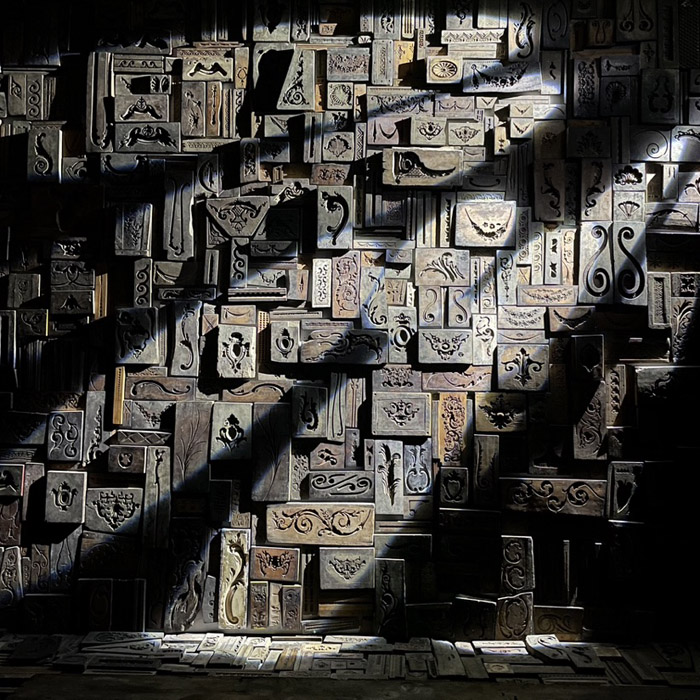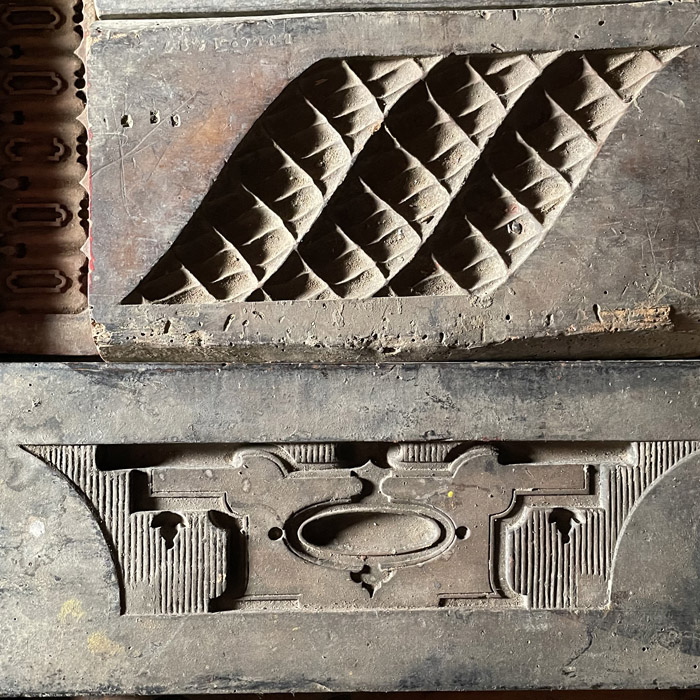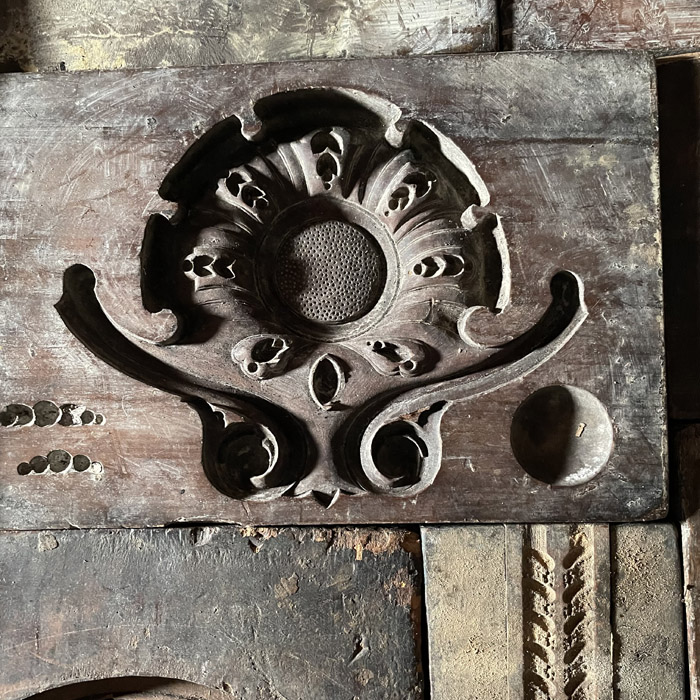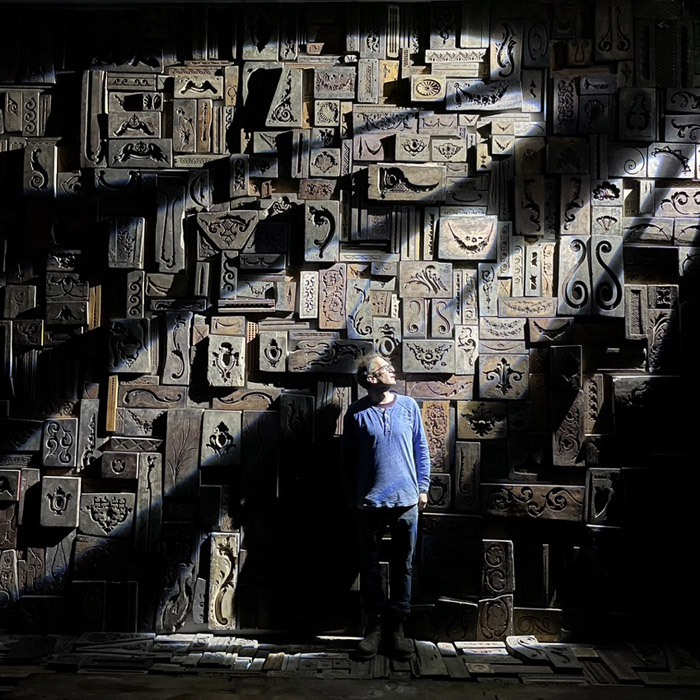The Tucker Collection of Frame-makers’ Moulds
At LASSCO Three Pigeons we have just bought a vast collection of carved wooden frame-makers’ moulds. They are drawn from the mould-libraries of a number of different picture frame-makers’ workshops. The moulds being carved from wood, and wood being inflexible, they are not for making casts in plaster (you’d never get the cast out in one piece). They are for casting in Composition.

Often referred to as “compo”, composition is created using a heated mix of “whiting” (very fine casting plaster) blended with two-part animal glue. Once mixed, the composition – in a plasticine consistency – is forced into the carved mould in a press. The resultant cast is eased from the mould whilst the composition is still pliant and is then stuck to the prepared picture frame with glue size. The positive casting has the elasticity to retain the hollows and under-cuts of the negative mould as it is extracted. Once the form of the picture frame is complete the composition is left to harden off before being prepared with a gesso primer coat and a “bole” to which gold-leaf is applied. The result is a finely ornamented gilded picture frame – apparently carved.

By these means framers could meet the demand for ornate gilded picture frames – identical ones in series if required. It was comparatively quick and the skilled origination work of carving the ornament only needed doing once – in the negative.
Picture frames, mirror frames and internal architectural ornament can be embellished in this way. It became popular in the late 18th Century and was championed by Robert Adam amongst others – he used both composition and papier maché to create the ornamentation applied to fire surrounds, pilasters and overdoors.
Into the 19th Century the desire to hang paintings generally, and portraits in particular, saw the rise of the fashionable salons and an enormous demand for picture frames. The use of composition became the norm and the method allowed picture frames to become ever larger, more ornate and grandiose. In time the Royal Academy were banning pictures submitted to the Summer Exhibition that arrived in a frame deemed too exuberant – they were hogging too much wall-space.

A Victorian handbook extols the benefits of the technique: ”The composition ornament is exceedingly pliant and supple, and may be bent into almost any form without breaking or injuring it; it is this property which makes these ornaments so convenient; as they may be applied to the round, the flat, or the hollow parts of the frame, with almost equal ease.”
Jacob Simon in “The Art of the Picture Frame” notes that
“Compo came to be used very widely by gilders and framemakers but they depended on the superior skills of the carvers who cut the finely detailed boxwood moulds which were used for pressing the and producing the compo ornament”.
The moulds here are from numerous Victorian workshops – a few of them are stamped with workshops such as “John Baker & Co., Kensington” and “Veronese”, and some with the carver’s name “J. Newcombe” and ”M. Thompson”. Whilst some are carved in boxwood there is a variety of timbers used – including various fruitwoods, cedar and a couple in lignum vitae – any off-cut of any tightly grained timber seems to have been utilised by the carvers.
Christopher Tucker
This vast collection (the display wall pictured represents a small part of the moulds salvaged) was put together by Christopher Tucker (1941-2022).

Tucker was in the film business. Originally an opera singer who had discovered his calling when he made his own prosthetic nose for one role, he went on to become the best in the business for prosthetic make-up and Monster design in an age just before the dawn of Computer Generated Imagary (CGI) special effects.
His was the extraordinary work for “Elephant Man” – Tucker was brought in at the last minute to save the day and with a week to go, and no sleep, he delivered one of the most famous make-up transformations in film. The diverse inter-galactic aliens seen meeting in the bar in “Star Wars” were Tucker’s creations. The were-wolves in “The Company of Wolves” were his, as were the mutants on Mars in “Total Recall”. On stage Tucker produced the mask and make-up for “The Phantom of the Opera” for successive productions over many years. On TV his work was seen in various productions including “Dr. Who”. Tucker revelled in the gruesome: the famous Monty Python scene in “The Meaning of Life” with Mr Creosote – the glutton who is persuaded to ingest “… a tiny wafer thin mint” – pushed the envelope somewhat, as did the challenge to extend the manhood of a pornstar with a priapic prothesis.

Tucker spent years viewing the Picture Frame auctions at Bonhams (Lots Road) and Christies (South Kensington) and elsewhere – his partner in tow. They would hone-in on the boxes of framer’s moulds and video each one and bid on them enthusiastically. He would put his workshop into action casting from them and re-moulding them in flexible silicone moulds (which does enable a plaster cast to be produced). This work would keep his workshops at “CTS” – Christopher Tucker Sculpture – in continuous production between films.
Christopher Tucker passed away in December 2022 – his obituary was published in The Times and The Guardian and elsewhere. His huge collection of props, casts and film memorabilia has been sold. LASSCO bought about 160 boxes of frame-maker’s moulds from his warehouse – a truly extraordinary collection; the result of many thousands of hours of intricate carving in Victorian workshops.
Anthony Reeve,
LASSCO Three Pigeons, April 2023
The moulds are available in groups of between 30 and 50 in a box – great for creating a display wall. Some of the more interesting carvings will be sold individually. Search “moulds” or see a selection of the moulds that are now available: here. (now Sold – see below).
Editor’s Update: This story has been picked up by World of Interiors – they came to talk to us and photograph the wall of moulds – the resultant piece can be found here.
A further Editor’s Update: All of the moulds have now Sold.
